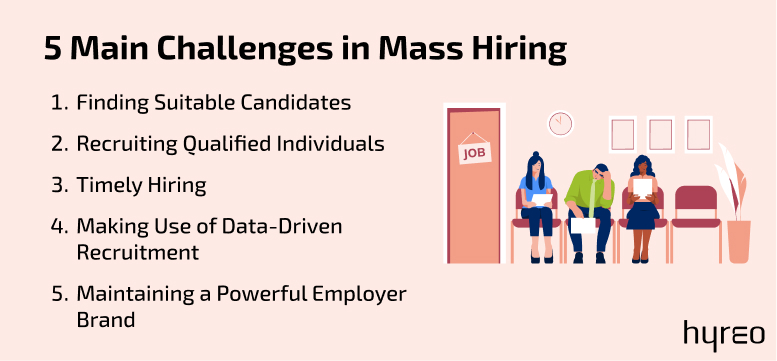Mass recruiting can be difficult and stressful for recruiters since the process involves hiring a large number of the best candidates in a brief amount of time. Many businesses accelerate their hiring processes to meet the demands of a growing business. Mass hiring is usually done by firms that are rapidly scaling their operations and needs a large number of personnel to support their latest projects.
Mass hiring encompasses more than just hiring from a large talent pool. The process of mass recruiting necessitates internal evaluation, planning, and coordination within the business. Before interviews can take place, a lot of preparation is required for a successful mass hiring effort. The process can also go beyond the moment at which a prospect accepts an offer; onboarding plans and attrition are also part of the mass hiring process.
What Does Mass Hiring Mean?
Mass hiring is a process whereby corporations hire a larger number of recruits than usual in a relatively short amount of time. It requires extensive preparation, resources, and collaboration throughout the organization to ensure high hiring efficiency and a positive candidate experience.
Loosely defined, bulk hiring entails the recruitment of a large talent pool in a short period. Moreover, the process is distinctive to each business. Hiring five candidates in a month could be mass hiring for a firm with twelve employees that typically recruits just one person annually.
Google, on the other hand, recruits over a thousand new workers every month, but since this is normal for the corporation, it does not qualify as mass hiring. Mass recruiting is an effective technique for rapidly expanding a company’s staff, but is not without its drawbacks, like unsatisfactory applicant experiences.
What are the Challenges Faced in Mass Hiring?

#1 Finding Suitable Candidates
Finding the best applicant in a field of underqualified candidates can often be like finding a needle in a haystack. So, the candidate hired during a particular recruitment drive may not be the ideal candidate.
So, it’s important to not cut corners to fill positions quickly, since this could cost the business more money in the long run. One of the best methods to deal with a large volume of candidates is to automate as many processes as possible, to narrow them down into better-qualified candidates.
#2 Recruiting Qualified Individuals
Great candidates with niche skills are often contacted directly by recruiters, even when they are not actively searching for a new role. If these candidates are active job seekers, they are likely to receive several job offers at the same time.
Hence, while approaching these candidates, it is important to do some research and personalize your sourcing emails. This way, you can appeal to what drives them and keeps them happy at the workplace.
#3 Timely Hiring
Vacant positions delay operations and hence cost money. While it’s tempting to fill these positions fast with mass recruitment, it is important to diligently follow all recruitment processes like talent sourcing and application screening to hire the best candidates. However, depending on the industry or position, making a hire can take several weeks or months, straining time and resources.
On the hand, the recruitment princess itself may be lengthy which could result in qualified prospects accepting other offers.
#4 Making Use of Data-Driven Recruitment
Companies may utilize acquisition data and statistics to improve their hiring process and make better judgments. However, gathering and analyzing data can be time-consuming.
For example, using Spreadsheets, which is one of the most common methods of tracking recruiting data, involves manual labor.
Moreover, these manual methods have room for human errors and are not always reliable. This makes it more challenging to track data and trends.
Instead of manual methods, hiring teams store data, track recruiting metrics, and generate reports with an Applicant Tracking System (ATS).
#5 Maintaining a Powerful Employer Brand
Employer branding has a positive impact on recruiting and can help attract and engage better candidates. In fact, organizations that invest in branding are three times more likely to make quality hires. Creating a positive applicant experience is an important part of employer branding.
During mass recruitment drives, it might be hard to stay on top of emails or calls from prospective candidates who are eager to know how their interview went, when the next interview is, etc.
Failing to reply courteously and quickly to all queries may lead to unsatisfactory applicant experiences, hence affecting the employer brand.
Read – 8 Impactful Strategies to create a Solid Employer Brand which works in 2023.
#6 Providing a Positive Candidate Experience
Candidate experience is a great internal marketing strategy and can attract suitable applicants while assessing job offers. The way applicants are treated during the recruiting process reflects how they would be treated once hired.
They would be less inclined to accept an offer if they have unsatisfactory recruiting experience. Positive applicant experiences, on the other hand, will boost the image of the organization and inspire qualified individuals to apply for and consider the job offer.
You can use Hyreo to facilitate a great candidate experience.
#7 Establishing an Effective Recruitment Procedure
Hiring teams must be able to communicate quickly, assess prospects rapidly, and stay informed at all times. Seamlessly coordinating all these aspects can sometimes be quite challenging for recruiters.
In addition, administrative tasks like scheduling interviews, taking calls, shortlisting resumes, etc., can take away the recruiting team’s focus from coordinating the hiring process and providing satisfactory client experiences.
8 Strategies For Effective Mass Hiring
#1 Form an ‘A-Team’
The most important element for an effective mass hiring campaign is a competent team that can assist in reaching goals. However, the power is in utilizing existing employees who have prior knowledge and experience in the sector you are hiring for. The contributions and insights of the team will have a significant impact on the recruitment process. To do so:
- Analyze the requirements and establish a realistic goal.
- Assess candidates with the qualifications you are looking for on social media or job-posting websites to get an idea of the market.
- Make the job description crystal clear. If possible, enlist the assistance of those who are already working in the department for which you are hiring. Have them outline the critical talents and skills that applicants must possess to perform well. The job analysis will help the selection process.
- Establish a hiring timeline. Set a realistic timeframe and divide it into phases.
- Some roles may need you to fill in positions sooner than others. You’ll know this by establishing what and how many vacancies you need to fill ahead of time.
- Don’t undervalue the costs. There are bound to be a few oversights within any strategy as unexpected costs come into the picture.
#2 Establish a Strategy
The next phase in a successful mass recruiting strategy is implementing a comprehensive hiring plan that encompasses sourcing, screening, hiring, and onboarding.
Gather basic information about all of your prospects, such as their availability, experience, and skill sets, and then use AI to analyze the results and rate candidates based on pre-set parameters. If you are looking for certain skill sets or expertise, you could even design a brief online evaluation and utilize AI to identify and shortlist competent individuals swiftly.
Like with just about anything else, recruitment is a space where planning is everything when it comes to executing a successful recruitment drive. It would also help if headhunters used technology to augment their strategies.
#3 State Job Roles & Responsibilities Explicitly
Objectives and expectations should clearly be defined, and the duties and tasks that each position requires should be explained with clarity, and not merely described with a rough sketch of important skills and needs. These will help in finding the ideal applicants. Define the priorities and the preferable qualifications of the best candidates.
#4 Network
A significant component of mass recruiting tactics is expanding sourcing networks to reach several ideal applicants in one go. To reach a large pool of applicants, you may need to employ various channels. These include:
- Programmatic advertising.
- Making use of existing staff referrals.
- Informing your contacts.
- Creating dedicated pages on major social media platforms for recruitment activities and directing potential prospects to them.
- Accepting applications on the spot and encouraging possible walk-ins.
- Collaborating with local organizations such as NGOs, government agencies, and training programs.
#5 Plan the Interview
An organized interview structure is the next crucial aspect of a successful mass hiring effort. Research has proven that a structured interview process has a higher success rate as compared to a non-structured assessment method. Furthermore, a framework is critical when a large number of candidates need to be hired in a short time.
#6 Always Follow-Up
Any recruiting campaign requires follow-up. The prospects will want to know how they have fared in the hiring process, especially if multiple interview rounds are involved.
As a result, it is critical to maintain a line of contact with applicants by following up with them and informing them of how things are going, what the next phase in the recruiting process will be, and how they can prepare for this.
#7 Plan the Onboarding Procedure
It is important to provide a remarkable candidate experience throughout the initial onboarding process to encourage newly hired workers to do their best at your organization. One of the most crucial parts of a mass hiring campaign is onboarding.
It is more advantageous to begin the onboarding process for a large group of applicants once a week rather than enrolling a limited number of applications every day. It will not only make the process more efficient and systematic but will help ensure an exceptional applicant experience.
You can even opt for onboarding software.
#8 Review Employment Processes Regularly.
There is no such thing as a perfect hiring procedure. Every recruiting process has some flaws that must be tweaked from time to time to make it more effective, especially if a company has regular mass hiring drives.
Many things can go wrong when recruiting applicants in large numbers, from a pre-mature screening procedure to ignored follow-up calls. A continual evaluation can help you detect gaps in your hiring process and bridge them instead of letting the entire process unravel.
Final Thoughts
Mass recruiting can be stressful for those involved since it involves identifying, interviewing, hiring, and onboarding the best candidates in a short time period. However, if properly planned and executed, mass hiring can undoubtedly provide the best results.
During a mass recruitment drive, it is essential to refrain from sacrificing candidate quality. While this may help get new employees in the door, it will cause a significant problem later on if they are unsuitable for the post. Careful planning, improving recruiting processes, and judicious use of skills evaluations can help maintain recruitment standards, even for large talent pools.
FAQs on Mass Hiring
Why do businesses hire in large numbers?
Mass recruiting is the best option companies have when scaling up or starting a large project. Companies hold job fairs, examine resumes, and conduct interviews to find the best individuals.
Is mass hiring a good thing?
Mass recruiting is an effective technique for rapidly expanding a company’s staff, but it is not without drawbacks, particularly negative applicant experiences. However, with appropriate preparation, these concerns can be prevented.
What is the most complicated aspect of mass staffing?
The most complicated aspects of mass staffing are analyzing data to identify the right candidates, conducting interviews, onboarding, negotiating terms, training, and posting job descriptions on the right job boards.
What are the reasons for ineffective recruitment?
Some of the reasons for ineffective recruitment drives include setting unquantifiable goals, specifying target demographic, solely using social networking sites as employment boards., improper identification of points of sale, and allowing biased judgments.
What are the top five recruitment strategies?
1. Building an applicant persona for difficult-to-fill positions.
2. Ensuring a satisfactory candidate experience.
3. Creating an effective employee referral program.
4. Working on lowering prejudice.
5. Recognize the right talent.




